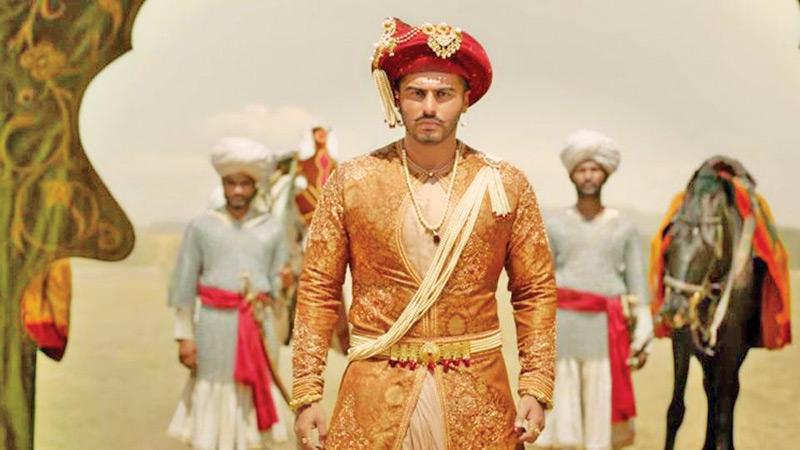
The latest Bollywood movie Panipat - The Great Betrayal, directed by Ashutosh Gowarikar, is screened at the Majestic, City Centre, Liberty Scope in Colombo and Milano in Kegalle. The film stars Arjun Kapoor, Sanjay Dutt, Kriti Sanon and Zeenat Aman.
Panipat is set in 1761, when the Maratha Empire had reached its zenith and their grip on Hindostan reigned supreme with no one to challenge them until an invader set his eyes on the throne. That’s when Sadashiv Rao Bhau (Arjun Kapoor), the Commander-in-Chief of the Maratha Army led a northern expedition to repel the invading forces of Ahmad Shah Abdali (Sunjay Dutt), the king of Afghanistan. The war epic entails the events that led to the third battle in Panipat.
Mughal Empire
In an email interview I had with Nagalingam Kumarakuruparan, an Indian journalist and Indologist based in Hyderabad, it is evident that the Marathas are from the Western part of India, especially, from the Maharashtra region. The Marathas are very brave and powerful people. They challenged the Mughal authority in Deccan and did not allow them to penetrate to the South of India. Being devout Hindus, Marathas resented Mughal rule in India. Marathas came into prominence only during the reign of Mughal ruler Aurangzeb who followed a policy of religious intolerance. Then they decided to challenge the Mughal Empire.
Marathas emerged as a force under the leadership of Shivaji in the 17th century posing a threat to the Mughal Empire. Being a great nation builder, Shivaji inspired a sense of nationalism and patriotism in the Marathas. Shivaji’s successor Sadashiv Rao Bahu captured the Attock Fort in Punjab and brought the Mughal Empire under his control. However, the expansion of the Maratha Empire was fraught with danger. There was widespread misunderstanding among the leaders. They also incurred the wrath of the Afghan warlord Ahmed Shah Abdali.
The Marathas and the enemy forces fought a decisive battle in Panipat on January 14, 1761. As a war strategy, Abdali cut off the lines of communication of the Marathas. Sadashiv Rao Bhahu who was proud of his artillery strength fought a bitter battle against the advice of his generals. At the start, the Marathas were clear winners of the battle, but the Afghan forces destroyed the Maratha infantry using small cannons mounted on camels. Sadashiv Bhahu was killed in the battle and nearly 40,000 Maratha soldiers lost their lives. The Maratha women who accompanied the soldiers killed themselves by jumping into wells. Thus the battle of Panipat proved to be a great disaster to the Marathas.
Deadly conflict
On his return journey to Afghanistan, Abdali committed heinous crimes but he thought of invading India again.
According to historian Sardesai, “Notwithstanding the terrible losses in manpower suffered in the battlefield by the Marathas the disaster decided nothing.” Another historian, Elphinstone said, “Never was there a calamity that diffused so much consternation.” According to Sir Jadunath Sarkar, “The third battle of Panipat decided the fate of India.”
While the Marathas were weakened in the deadly conflict, other strong rulers of the principalities of the subcontinent remained just onlookers. The Marathas’ battle for survival facilitated the aims and ambitions of the British who were waiting to have a foothold in India. If the war at Plasssey in the Eastern part of India had sown the seeds of British supremacy in the subcontinent, Panipat afforded time for the maturing and striking of their roots. Although the Marathas had dominated almost the whole of Western India and Delhi, their dream of building an empire was shattered by the defeat in the battle of Panipat. One of the major causes of their defeat was attributed to the betrayal of a few powerful chieftains who had their allegiance to the Mughals.
The story in the film is close to reality. The director has presented the Maratha Empire in all its glory. The battle scenes are really breathtaking. The main actor Arjun Kapoor’s physique comes in handy for his robust character. Indeed he looks like a real warrior. Kriti Sanon gives an impressive performance, but her presence in the film is rather limited.
Zeenat Aman as Sakina Begum is excellent in the cameo and her scene with Kriti Sanon is one of the highpoints in the film. Muraleedharan’s cinematography is spectacular as he has captured the battle scenes and the few romantic scenes quite elegantly. Raju Khan’s choreography is remarkable and the production design visually stunning. As the film runs for nearly three hours, the director should have included at least two more songs and romantic scenes. Ultimately, films are made primarily for entertainment.
